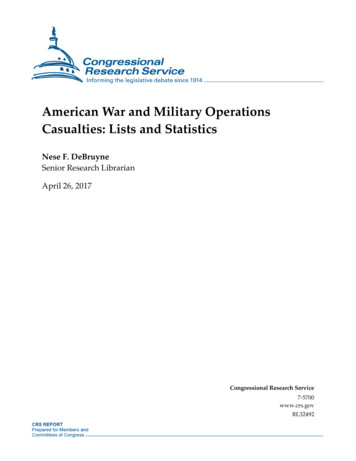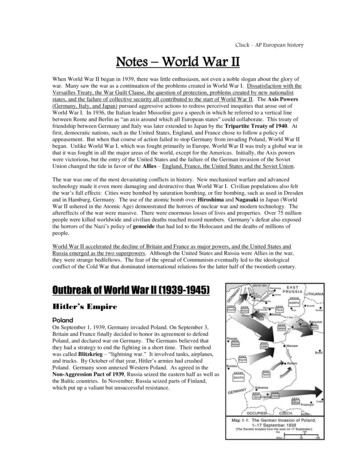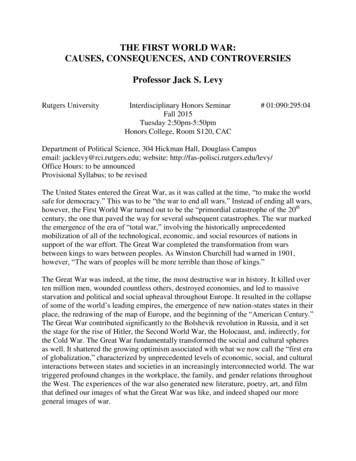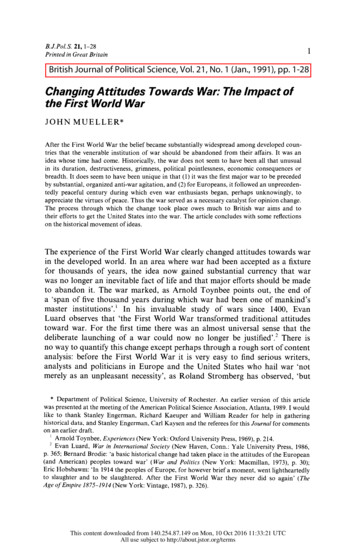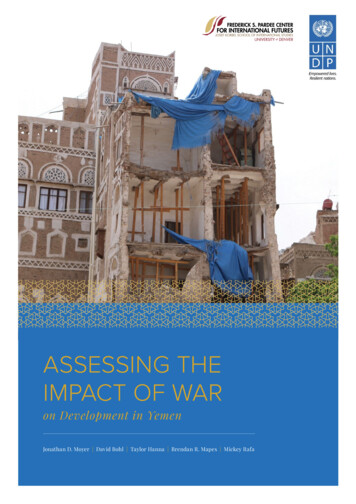
Transcription
ASSESSING THEIMPACT OF WARon Development in YemenJonathan D. Moyer David Bohl Taylor Hanna Brendan R. Mapes Mickey Rafa
DISCLAIMERThis report presents the findings of a commissioned study on the impact of war ondevelopment in Yemen, through scenarios using the Sustainable Development Goals lens.The views expressed in this study are those of the author(s) and do not necessarily representthose of the United Nations, including UNDP, or the Member States of the United Nations.Furthermore, the designations employed herein, their completeness and presentation ofinformation are the sole responsibility of the author(s) and do not necessarily reflect theopinion of the United Nations Development Programme.Copyright 2019By United Nations Development Programme (UNDP)60th Meter RoadP.O. Box: 551 Sana’a, Republic of YemenWebsite: http://ye.undp.orgAll rights reserved. No part of this publication may be reproduced, stored in a retrievalsystem, or transmitted in any form or by any means, electronical, mechanical,photocopying, recording or otherwise, without prior permission of UNDP
ACKNOWLEDGMENTSThe core team for this report comprised Dr. Jonathan D. Moyer, Assistant Professor andDirector of the Frederick S. Pardee Center for International Futures, Josef Korbel Schoolof International Studies, University of Denver; Mr. David Bohl, Senior Research Associate;Ms. Taylor Hanna, Research Fellow; Mr. Brendan Mapes, Research Fellow; and Mr. MickeyRafa, Assistant Director of Research Operations.From UNDP Yemen Country Office, all discussions were led by Mr. Auke Lootsma, ResidentRepresentative; Ms. Asmaa Shalabi, Strategic Advisor; MS. Leanne Rios, Communicationand Advocacy Team Leader; and Mr. Abdo Seif, Team Leader, Management Support Unit,Sustainable Development Goals Focal Point.From the Regional Bureau of the Arab States (RBAS) Mr. Mourad Wahba, Regional Director;Ms. Sarah Poole, Deputy Regional Director, Ms. Melanie Hauenstein, Regional Advisor; Mr.Adel Abdellatif, Senior Strategic Advisor; and Ms. Rima Al-Hassani Regional Specialist.UNDP Regional Bureau of the Arab States Hub team in Amman comprised of Mr. KhaledAbdelshafi, Regional Hub Manager; Mr. Jos De La Haye, Team Leader Governance andPeace Building; Ms. Nathalie Bouche, Team Leader Sustainable and Inclusive Growth; Mr.Samuel Rizk, Team Leader Conflict Prevention and Peacebuilding; Ms. Frances Guy, GenderTeam Leader; Ms. Kawtar Zerouali, Regional Programme Manager; Ms. Nadia Alawamleh,Country Programme Specialist; and Mr. Fekadu Terefe, Programme Specialist/InclusiveGrowth and Sustainable Development.From UNDP BPPS New York, Ms. Laurel Patterson, Director SDG Integrator team, Mr. LarsJensen, Economist, Ms. Tasneem Mirza, Economist for their technical inputs throughoutthe preparation of the study.Finally, we would like to dedicate a special thanks to the peer reviewers for valuablefeedback, while reiterating that the views expressed in the report are those of the authors,and do not necessarily reflect those of the peer reviewers. Thank you to Dr. Hannes Mueller,Researcher at the Institute of Economic Analysis (IAE-CSIC) in Universitat Autònoma deBarcelona; Dr. Håvard Mokleiv Nygård, Research Director, Conditions for Violence andPeace, Peace Research Institute Oslo (PRIO); Dr. Yahya bin Yahya Al Mutawakel, Professorat Sana’a University and former Minister of Industry and Trade; Mr. Ahmed Bazaraa,Businessmen and Member of the National Dialogue Conference; Abdulwahab Alkebsi isthe Managing Director for Programs at the Center for International Private Enterprises inAfghanistan, Pakistan, and Ukraine, and at CIPE’s head office in Washington; and ProfessorBarry B. Hughes, Founding Director of the Frederick S. Pardee Center for InternationalFutures, Josef Korbel School of International Studies, University of Denver.3
PREFACEThis study on the “Impact of War on Development in Yemen”, was commissioned end of2018 in collaboration with Frederick S. Pardee Center for International Futures, Josef KorbelSchool of International Studies, University of Denver. The researchers undertook theanalytical work with a desire to understand the impact of war in Yemen across human,social and economic dimensions of development. The analysis was undertaken by calibratinga quantitative modeling system called International Futures (IFs) to fit the availableinformation on the impact of war in Yemen to date, and then create four hypotheticalanalytical scenarios to be explored. One where the conflict ends in 2019, 2022 and finallyone where conflict extents all the way to 2030. To assess the impacts from the conflictacross the three conflict scenarios the fourth scenario represents a counter-factual worldin which conflict did not escalate beyond 2014. The result is an impact study that quantifiesthe damages of the war in Yemen across multiple dimension of development such as lossof lives, health, demographics, education, infrastructure and the economy, etc.The study is intended to advocate to the parties to the conflict on the consequences ofthe conflict on medium- and long-term development, as recovery to the pre-conflict levelswould require two to three generations. At the same time the study intends to inform thegeneral public, including the international community, about the level of devastation causedby the conflict in Yemen, and ask those who have influence over either party to the conflictto urgently push towards a sustainable peace deal and a stop to further escalation. Thesituation is already extremely severe. If it deteriorates further it will add significantly toprolonged human suffering, retard human development in Yemen, and could furtherdeteriorate regional stability.4A S S E S S I N G T H E I M PA C T O F C O N F L I C T O N H U M A N D E V E L O P M E N T I N Y E M E N
EXECUTIVESUMMARY
Prior to the escalation of conflict in 2015, development in Yemen was strained.A country of 30 million people, Yemen ranked: (a) 153rd on the HumanDevelopment Index (HDI); (b) 138th in extreme poverty; (c) 147 th in life expectancy;(d) 172nd in educational attainment; and, (e) was in the World Bank low-middleincome category. Projections suggest that Yemen would not have achieved any ofthe Sustainable Development Goals (SDGs) by 2030 even in the absence of conflict.The ongoing conflict has further reduced the pace ofdevelopment. The impacts of conflict in Yemen aredevastating—with nearly a quarter of a million peoplekilled directly by fighting and indirectly through lackof access to food, health services, and infrastructure.Of the dead, 60 per cent are children under the ageof five. The long-term impacts of conflict are vast andplace it among the most destructive conflicts since theend of the Cold War. The conflict has already set backhuman development by 21 years (Figure 1). If the conflictwere to end in 2022, development would be set back26 years—over one generation. If the conflict persiststhrough 2030, the setback grows to nearly fourdecades, or more than one-and-a-half generations. Inthis case, one-in-five surviving Yemenis will bephysically stunted because of the conflict.This report is motivated by a desire to better understandthe impact of conflict in Yemen across multiplepathways of human development. We assess this bycalibrating the International Futures (IFs) model andusing it to create four alternative scenarios. Thesescenarios reflect three potential pathways of conflictdevelopment (ending in 2019, 2022 and 2030), as wellas a counterfactual world in which conflict did notescalate after 2014. These scenarios are then used toestimate the impact of conflict on development acrossmultiple issue areas (demographic, economic,education, infrastructure, health, etc.).F i g u r e 1 How long does conflict in Yemen set back human development?Human Development Indexyears set back at the end of the conflict1990200020102020203020191998 (21-year setback)20221996 (26-year setback)20301991 (39-year setback)6A S S E S S I N G T H E I M PA C T O F C O N F L I C T O N H U M A N D E V E L O P M E N T I N Y E M E N
2019IMPACT233,000DEATHS(0.8 per cent of the 2019 population) with 102,000combat deaths and 131,000 indirect deaths due tolack of food, health services and infrastructure140,00017%If the conflict were to end in 2019, it would account for:deaths of childrenunder the age of fiveof the population living withmalnutrition (13.4 million years ofthe total population in 2019)36%US 89Bloss in economic outputEXECUTIVE SUMMARY&140%of people living in extremepoverty (44 million years ofthe 2019 population)CHILDDEATHevery 11 minutesand 54 secondsin 201914%of children living withmalnutrition (1.6 million ofthe 2019 child population)of children without access to schools (10.3 millionyears of school-aged children in 2019)US 2,000reduction in Gross Domestic Product (GDP)per capita (at Purchasing Power Parity (PPP))7
2022IMPACT482,000DEATHSIf conflict continues, the cost in mortality, especially the lives of children,will grow. In a scenario that assumes reduced conflict intensity relativeto 2018, but continued large-scale violence through 2022, we estimatethat fighting will account for:331,00024%deaths of children under the age of five49.4 %of people living in extremepoverty (86.6 million yearsof the 2022 population)43%2030IMPACTin lost economic output(4.6 per cent of the 2030 population) with 296,000people dying directly in conflict and an additional 1.48million people dying indirectly due to lack of food, healthservices and infrastructure55%deaths of childrenunder the age of fiveof people living in extremepoverty (265 million yearsof the 2030 population)48%of children without access toschools (57.4 million years ofschool-aged children in 2030)8&&CHILDDEATHevery 7minutesin 202231%of the population livingwith malnutrition (3.7million years of the2022 population)US 2,600reduction in GDP per capita (at PPP)If the conflict continues through 2030, it will increasingly anddisproportionately impact the lives of the youngest:1,500,00071%of children livingwith malnutrition(4.4 million yearsof the 2022 childpopulation)US 181Bof children without accessto schools (21.2 million years ofschool-aged children in 2022)1.8MDEATHS1(1.5 per cent of the 2022 population) with 166,000combat deaths and 316,000 indirect deaths due tolack of food, health services, and infrastructureof children living withmalnutrition (22.7million years of the2030 child population)US 657Bloss in economic output&1&CHILDDEATHevery 2 minutesand 24 secondsin 201984%of the population livingwith malnutrition (220.3million years of the2030 population)US 4,600reduction in GDP per capita (at PPP)A S S E S S I N G T H E I M PA C T O F C O N F L I C T O N H U M A N D E V E L O P M E N T I N Y E M E N
The conflict in Yemen is devastating to developmentgains and disproportionally impacts children. By 2030we estimate that indirect deaths (caused by lack ofaccess to food, health care and infrastructure services)will be five times greater than direct deaths. Most ofthose deaths are to infants and children, with anestimated 1.5 million killed by 2030 if conflict persists.Table 1 shows the impact of ending the conflict in 2019,2022 and 2030 on indicators of development comparedwith a No Conflict scenario.Ta b l e 1 Summary of results, reporting human development indicators in the lastyear of the conflict according to each scenario.ScenarioLast year of conflict2014201920222030Direct conflict deaths (cumulative difference)Conflict102,000166,000296,000Indirect conflict deaths (cumulative difference)Conflict131,000316,0001,484,000GDP per capita (PPP)thousand USNo Conflict3.84.04.35.9Conflict3.82.01.71.3Extreme poverty*percent of populationNo ant mortalitydeaths per 1,000 birthsNo alnourished childrenpercent of childrenNo oss Domestic Product (GDP) per capita, extreme poverty, and malnourished children 2014 data from World BankWorld Development Indicators (WDI); infant mortality 2014 data from UNPD World Population Prospects. *Poverty line ofUS 1.90 a day.It is difficult to conceptualize the scale of these impactson development. To better contextualize this, we usedquantitative clustering techniques to compare theconflict in Yemen with other conflicts since the end ofthe Cold War. We discovered that Yemen’s currentconflict is similar to others that are large, last for a longtime and have significant impacts on humandevelopment such as Iraq (2003–present), DemocraticRepublic of Congo (1992–present), Sierra Leone (1991–2002) and Liberia (2000–2003).This study has limitations and focuses narrowly on theimpact of conflict on development. We do not studythe drivers of conflict, unfolding conflict processes orthe potential for post-conflict recovery. We project ade-escalation of conflict from 2018-levels (in terms ofdeaths and impact on the economy) and also makeassumptions about how the conflict will unfold through2030, both of which drive many results.This report breaks important new ground in presentinga framework for understanding how ongoing conflictimpacts human development across multipledimensions. It builds upon academic work studyingthe impact of conflict on development, systemsdynamics and traditional integrated assessmentquantitative modeling.9
CONTENTSExecutive Summary. 5List of acronyms used in this report. 12Introduction. 13History of the current conflict in Yemen.15What are the known impacts of armed conflict on development?.19Conflict and demography. 21Mortality. 21Fertility. 21Migration. 21Conflict and economic development. 22Growth, trade and investment. 22Infrastructure. 23Agricultural production. 23Conflict and human capabilities.24Poverty.24Morbidity.24Education. 25Conflict and gender. 26Methodology. 27Analysis of the impacts of conflict on development in Yemen. 33Evaluating the “no conflict” scenario. 34The measured impact of conflict through early 2019. 35The future impact of conflict on development in Yemen.37Contextualizing the conflict in Yemen with previous conflicts.43Conclusion. 4510A S S E S S I N G T H E I M PA C T O F C O N F L I C T O N H U M A N D E V E L O P M E N T I N Y E M E N
Annex 1: Data Estimates and Notes. 47Conflict Deaths. 48GDP Growth Rates. 50Poverty. 52Annex 2: Modeling Assumptions.55Conflict Scenarios. 56Calibration for Conflict Deaths and Magnitude. 56Calibration for GDP.57Calibrating Poverty.57Calibration for Agriculture. 58Calibration for Education. 58Calibration for Energy. 59Calibration for WASH. 59Calibration for Nutrition. 59Calibration for FDI. 60Calibration for Revenues. 60Calibration for Migration. 60No Conflict Scenario. 60Calibration for Violence. 60Calibration for GDP. 60Bibliography. 61Photography Credits.68CONTENTS11
LIST OF ACRONYMSUSED IN THIS REPORTACLEDArmed Conflict Location and Event DataProjectAQAPAl-Qaeda in the Arabian PeninsulaBBOEBillion Barrels of Oil EquivalentCSOCentral Statistics OfficeCSPCenter for Systemic PeaceEIAEnergy Information AdministrationFAOFood and Agriculture OrganizationFDIForeign Direct InvestmentGCCGulf Cooperation CouncilGDPGross Domestic ProductGIEWSGlobal Information and EarlyWarning SystemGPCGeneral People’s CongressHBSHousehold Budget SurveyHDIHuman Development IndexIAMIntegrated Assessment ModelIDPInternally Displaced PersonIFsInternational FuturesIMFInternational Monetary FundIPCIntegrated Phase ClassificationISILIslamic State in Iraq and the LevantJMPJoint Meeting PartiesMERMarket Exchange RatesMoPICMinistry of Planning and InternationalCooperationOHCHROffice of the United Nations HighCommissioner for Human RightsPAMPartitioning Around MethodsPITFPolitical Instability Task ForcePPPPurchasing Power Parity12SAMSevere Acute MalnutritionSDGSustainable Development GoalSNASystem of National AccountsSTCSouthern Transitional CouncilUAEUnited Arab EmiratesUCDPUppsala Conflict Data ProgramUNUnited NationsUNCTADUnited Nations Conference on Tradeand DevelopmentUNDESAUnited Nations Department of Economicand Social AffairsUNDPUnited Nations Development ProgrammeUNESCOUnited Nations Educational, Scientificand Cultural OrganizationUNHCRUnited Nations High Commissionerfor RefugeesUNICEFUnited Nations International Children’sEmergency FundUNOCHA United Nations Office for theCoordination of Humanitarian AffairsUNSDUnited Nations Statistics DivisionUSDUnited States DollarsWDIWorld Development IndicatorsWEOWorld Economic OutlookWHOWorld Health OrganizationYERYemeni RialA S S E S S I N G T H E I M PA C T O F C O N F L I C T O N H U M A N D E V E L O P M E N T I N Y E M E N
INTRODUCTION
The current conflict in Yemen is one of the greatest preventable disastersfacing humanity. As such, many organizations have measured the impactof conflict on human suffering to better understand the severity of conflict.However, while the armed conflict has appropriately been the focus of muchattention, its developmental impacts have not been studied across multiplepathways. In addition, no study explores the impact of conflict in Yemen onthe Sustainable Development Goals (SDGs).Conflict has been occurring in Yemen for decades. Thecurrent armed conflict escalated significantly in 2015with clashes between the Houthi rebels and theGovernment of Yemen. It has embroiled a complex webof parties in addition, including southern separatists,terrorist organizations, informal militias and local tribalgroups. Civil wars with many parties, such as this one,often take longer to resolve and complicate negotiationswhich results in extended periods of fighting.1As the conflict continues, however, its costs—bothdirect and indirect—have become immense. Apreliminary assessment estimated the 2015 physicaland economic damage to be over US 15 billion. 2 From2016–2018, over 63,000 combatants and civilians werekilled due to direct violence. 3 If 2019 deaths continueat their current rate, over 22,000 more will die beforethe year’s end. In December 2018, two million Yemeniswere internally displaced, 89 per cent of whom havebeen displaced for more than a year.4 More than 2,500schools in 20 governorates have been damaged oroccupied by internally displaced people (IDPs) or armedgroups.5 Significant damage has been done to foodproduction and distribution systems,6 while blockades,sieges and the destruction of crucial water infrastructurehas weaponized water.714Perhaps the greatest tragedies of the conflict havebeen the scale of suffering from hunger, poverty andsickness. Over half of the population is in IntegratedPhase Classification (IPC) “Phase 3”—the crisis phaseof the Famine Early Warning Systems Network. 8Malnutrition has grown from an already high level andhas resulted in 45 per cent of deaths of children underthe age of five.9 An estimated 3.3 million children inthe country are malnourished, with one million sufferingfrom moderate acute malnutrition and over 400,000from severe acute malnutrition (SAM).10 Between April2015–October 2018, Save the Children estimates SAMcaused the death of over 84,000 children.11 And poorwater and sanitation conditions have contributed tothe largest cholera outbreak in epidemiologicallyrecorded history 12 with more than 1.3 million suspectedcases and over 2,600 associated deaths since the April2017 outbreak.13These estimates come from an assortment oforganizations attempting to calculate the impact ofarmed conflict on aspects of development in Yemenand serve as the backbone of the analysis in this report.We build upon these studies by: (a) conceptualizing animpact model of armed conflict on development, buildingupon academic literature; (b) calibrating a quantitativemodel to simulate various conflict and no-conflictscenarios; and, (c) using clustering techniques to bettercontextualize how armed conflict in Yemen relates toother conflicts since the end of the Cold War.The remainder of the report presents Yemen’s historyof conflict followed by a literature review assessingprevious research on the impacts of armed conflict ondevelopment. Our modeling methodology is alsooutlined, which draws upon the International Futures(IFs) tool to better contextualize the impact of theconflict on development. And, finally, we present resultsthat explore: (a) Yemeni development in the absenceof conflict; (b) how conflict has impacted SDGachievement; and, (c) the impact of conflict ondevelopment if it ended in 2019, 2022 and 2030.A S S E S S I N G T H E I M PA C T O F C O N F L I C T O N H U M A N D E V E L O P M E N T I N Y E M E N
HISTORY OF THECURRENT CONFLICTIN YEMEN
The conflict in Yemen has been described in various ways including as a proxywar between Iran and Saudi Arabia, a broader Shia-Sunni conflict, and abilateral struggle between the Houthi rebels and the Government of Yemen. Butthe reality is much more complex and “more closely resembles a region of ministates at varying degrees of war with one another—beset by a complex range ofinternal politics and conflicts—than a single state engaged in a binary conflict.”14The Republic of Yemen was established in May of 1990with the reunification of North Yemen (the Yemen ArabRepublic) and South Yemen (the People’s DemocraticRepublic of Yemen). Though formally a multi-partydemocracy, its first 20 years were led by President AliAbdullah al-Saleh, head of the General People’sCongress (GPC) and president of the North Yemen for12 years before reunification. The Joint Meeting Parties(JMP) formed as an unlikely opposition coalition of sixparties, including Islah, an Islamist/tribal party, and theYemeni Socialist Party, formerly the ruling party ofSouth Yemen.Separatist sentiment in the south has existed sincereunification, which left many southerners feelingmarginalized, and left out of Yemen’s economic andpolitical life. In 1994, tensions between some of thepolitical parties in southern and northern Yemenculminated in a brief civil war which was quickly won bythe north. This resulted in the exile of separatist leaders,forced the retirement of military officers and redistributedsouthern properties, including land.15 Some of the retiredofficers began leading peaceful protests in the 2000sand, in 2007, created the separatist Southern Movement(also known as al-Hirak).16In the northern governorate of Sa’dah, members of theZaydi Believing Youth movement were also challengingSaleh’s rule. The Zaydis ruled North Yemen for decadesbefore being ousted in the 1962 revolution. TheBelieving Youth movement arose protesting theregion’s underdevelopment as well as Yemen’scooperation with the United States during the invasionof Iraq in 2003.In 2004, President Saleh sent government forces toarrest the movement’s leader, Hussain al-Houthi,setting off a series of clashes in Sa’dah.17 Al-Houthi wasslain in 2004 but taking his name—and under theleadership of his brother—the Houthis continuedto battle Yemen’s government off and on for sixmore years.18In the last of these incidents, President Saleh set outto crush the rebellion with an “iron fist,” 19 and usedtactics that caused civilian collateral damage. Aceasefire was reached between the Houthis and thegovernment in 2010. However, the underlyinggrievances of the conflict were not addressed.Al-Qaeda in the Arabian Peninsula (AQAP)—the Yemenbranch of the militant Islamist organization al-Qaeda—formed in the 1990s. Through the 1990s and 2000s, itfocused on Western targets—most notably the attackon the USS Cole in the Aden harbor in 2000, killing 17.However, AQAP was not initially a concern to mostYemenis and did not pose the same existential threat16A S S E S S I N G T H E I M PA C T O F C O N F L I C T O N H U M A N D E V E L O P M E N T I N Y E M E N
HISTORY
the damages of the war in Yemen across multiple dimension of development such as loss of lives, health, demographics, education, infrastructure and the economy, etc. The study is intended to advocate to the parties to the conflict on the consequences of the conflict on medium- and long-term development, as recovery to the pre-conflict levels


